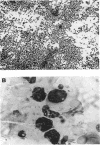Abstract
Initial susceptibility studies of Bilophila wadsworthia indicated significant resistance to several beta-lactam antibiotics, including imipenem and cefoxitin. NO beta-lactamase production was detected. However, some B. wadsworthia strains may grow as a heavy "haze" at up to the highest concentration of an antibiotic on standard antimicrobial agent-containing plates, and it is often difficult to determine the point at which conventional growth stops and haze growth begins. We investigated the nature of the haze growth of B. wadsworthia by using triphenyltetrazolium chloride (TTC) as an indicator of viability during antimicrobial susceptibility testing, by determining viability counts on antimicrobial agent-containing plates at various times, and by microscopically inspecting stained preparations of the growth on the control plate and the haze area. TTC MICs were determined by applying a TTC solution over the growth on plates inside the anaerobic chamber or within 5 min after exposure to air (aerobic TTC MICs). The haze growth reduced TTC in the chamber but not under aerobic conditions, whereas TTC was reduced by the conventional growth in both atmospheres. The aerobic TTC MICs correlated with the viability counts. Separated proteins resolved by polyacrylamide gel electrophoresis and isoelectric focusing showed TTC-reactive bands only when stained under anaerobic conditions, further demonstrating the sensitivity of TTC reduction to aerobic conditions. Microscopic examination of the haze growth indicated spheroplast formation. A new antibiogram for B. wadsworthia has been established by use of aerobic TTC endpoints; we believe that the lower MICs obtained with the TTC method are likely the ones that are clinically relevant and should be used in tests of B. wadsworthia. Also, we found that when the organisms were grown on pyruvate-containing medium, 87% of 56 strains tested were Beta-lactamase positive.
Full text
PDF






Images in this article
Selected References
These references are in PubMed. This may not be the complete list of references from this article.
- Baron E. J., Bennion R., Thompson J., Strong C., Summanen P., McTeague M., Finegold S. M. A microbiological comparison between acute and complicated appendicitis. Clin Infect Dis. 1992 Jan;14(1):227–231. doi: 10.1093/clinids/14.1.227. [DOI] [PubMed] [Google Scholar]
- Baron E. J., Summanen P., Downes J., Roberts M. C., Wexler H., Finegold S. M. Bilophila wadsworthia, gen. nov. and sp. nov., a unique gram-negative anaerobic rod recovered from appendicitis specimens and human faeces. J Gen Microbiol. 1989 Dec;135(12):3405–3411. doi: 10.1099/00221287-135-12-3405. [DOI] [PubMed] [Google Scholar]
- Bennion R. S., Baron E. J., Thompson J. E., Jr, Downes J., Summanen P., Talan D. A., Finegold S. M. The bacteriology of gangrenous and perforated appendicitis--revisited. Ann Surg. 1990 Feb;211(2):165–171. doi: 10.1097/00000658-199002000-00008. [DOI] [PMC free article] [PubMed] [Google Scholar]
- Bochner B. R., Savageau M. A. Generalized indicator plate for genetic, metabolic, and taxonomic studies with microorganisms. Appl Environ Microbiol. 1977 Feb;33(2):434–444. doi: 10.1128/aem.33.2.434-444.1977. [DOI] [PMC free article] [PubMed] [Google Scholar]
- Brazier J. S., Goldstein E. J., Citron D. M., Ostovari M. I. Fastidious anaerobe agar compared with Wilkins-Chalgren agar, brain heart infusion agar, and brucella agar for susceptibility testing of Fusobacterium species. Antimicrob Agents Chemother. 1990 Nov;34(11):2280–2282. doi: 10.1128/aac.34.11.2280. [DOI] [PMC free article] [PubMed] [Google Scholar]
- Citron D. M., Ostovari M. I., Karlsson A., Goldstein E. J. Evaluation of the E test for susceptibility testing of anaerobic bacteria. J Clin Microbiol. 1991 Oct;29(10):2197–2203. doi: 10.1128/jcm.29.10.2197-2203.1991. [DOI] [PMC free article] [PubMed] [Google Scholar]
- EIDUS L., DIENA B. B., GREENBERG L. Observations on the use of tetrazolium salts in the vital staining of bacteria. Can J Microbiol. 1959 Jun;5(3):245–250. doi: 10.1139/m59-028. [DOI] [PubMed] [Google Scholar]
- Jacobs M. R., Spangler S. K., Appelbaum P. C. Beta-lactamase production, beta-lactam sensitivity and resistance to synergy with clavulanate of 737 Bacteroides fragilis group organisms from thirty-three US centres. J Antimicrob Chemother. 1990 Sep;26(3):361–370. doi: 10.1093/jac/26.3.361. [DOI] [PubMed] [Google Scholar]
- Johnson C. C., Wexler H. M., Becker S., Garcia M., Finegold S. M. Cell-wall-defective variants of Fusobacterium. Antimicrob Agents Chemother. 1989 Mar;33(3):369–372. doi: 10.1128/aac.33.3.369. [DOI] [PMC free article] [PubMed] [Google Scholar]
- Laemmli U. K., Favre M. Maturation of the head of bacteriophage T4. I. DNA packaging events. J Mol Biol. 1973 Nov 15;80(4):575–599. doi: 10.1016/0022-2836(73)90198-8. [DOI] [PubMed] [Google Scholar]
- Mosmann T. Rapid colorimetric assay for cellular growth and survival: application to proliferation and cytotoxicity assays. J Immunol Methods. 1983 Dec 16;65(1-2):55–63. doi: 10.1016/0022-1759(83)90303-4. [DOI] [PubMed] [Google Scholar]
- Pegram R. G. The microbiological uses of 2, 3, 5-triphenyltetrazolium chloride. J Med Lab Technol. 1969 Jul;26(3):175–198. [PubMed] [Google Scholar]
- Rowland M. D., Del Bene V. E., Lewis J. W. Factors affecting antimicrobial susceptibility of Fusobacterium species. J Clin Microbiol. 1987 Mar;25(3):476–479. doi: 10.1128/jcm.25.3.476-479.1987. [DOI] [PMC free article] [PubMed] [Google Scholar]
- SLATER T. F., SAWYER B., STRAEULI U. STUDIES ON SUCCINATE-TETRAZOLIUM REDUCTASE SYSTEMS. III. POINTS OF COUPLING OF FOUR DIFFERENT TETRAZOLIUM SALTS. Biochim Biophys Acta. 1963 Nov 8;77:383–393. doi: 10.1016/0006-3002(63)90513-4. [DOI] [PubMed] [Google Scholar]
- SMITH F. E. Tetrazolium salt. Science. 1951 Jun 29;113(2948):751–754. doi: 10.1126/science.113.2948.751-a. [DOI] [PubMed] [Google Scholar]
- Walton J. R., Fulton F. Segregation during transfer of infectious drug resistance in Enterobacteriaceae. Nature. 1967 Jul 8;215(5097):179–180. doi: 10.1038/215179a0. [DOI] [PubMed] [Google Scholar]
- Wexler H. M., Finegold S. M. Media- and method-dependent variation in MIC values of ceftizoxime for clinical isolates of the Bacteroides fragilis group. J Chemother. 1991 Feb;3 (Suppl 2):12–19. [PubMed] [Google Scholar]
- Wexler H. M. Susceptibility testing of anaerobic bacteria: myth, magic, or method? Clin Microbiol Rev. 1991 Oct;4(4):470–484. doi: 10.1128/cmr.4.4.470. [DOI] [PMC free article] [PubMed] [Google Scholar]





